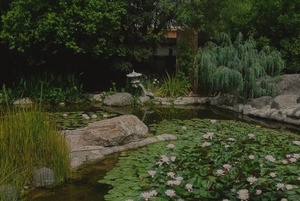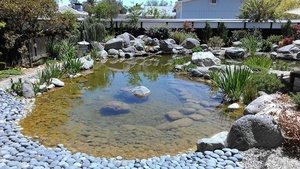Japanese gardens are very important in Japanese culture. Over many years the Japanese have become masters of gardening and have influenced many practices in gardening that are seen today(Japanese Garden Journal). The Yume Japanese Garden is a very beautiful garden that is comprised of many of the typical things that can be found in a Japanese garden. The many gardening trends that come from Japanese gardens that are seen at the Yume garden include; a koi pond, bamboo, zen rock garden, and carefully trimmed trees and bushes. Japanese gardens are more than just the plants and ponds that one might see when visiting a garden. Some of the other important aspects of a Japanese garden include; art, architecture, science, engineering, history, horticulture, and philosophy, It is all of those elements that come together in order to create the serene and beautiful gardens for people to visit. Japanese gardens are very articulate in the sense that everything in the garden serves a purpose. Japanese gardens require careful and frequent maintenance in order to keep the garden how it is supposed to look. Due to the fact that there is a lot of effort and intricate detail that goes into creating and maintaining a Japanese garden, Japanese gardens are seen as one of the most important elements of Japanese art(Kyuhoshi)2. One of the important things to not about Japanese gardens is that there are different kinds of Japanese gardens. Some of the different types of gardens include tea gardens, paradise garden, and rock zen garden as well as some other types of Japanese gardens. In Japanese culture there are three main styles of Japanese gardens. The three three main styles include Karesansui, Tsukiyama, and Chaniwa(Kyuhoshi). The different styles of garden represent a different meaning based off of how the garden looks(Kyuhoshi). The first style of garden, Karesansui, is a rock/dry zen garden. The rocks are used to represent rivers or the sea(Kyuhoshi). The second style of garden, Tsukiyama, are used to represent miniature versions of natural scenery(Kyuhoshi). The last style of garden, Chaniwa, is also known as the tea garden that has a tea ceremony house alongside the garden itself(Kyuhoshi). 
The Yume Japanese Garden offers a lot more than just a trip to the garden itself. The Yume garden host different events with their two most recent events being the folk celebration concert and the The Art of Kimono event. The Yume garden also hosts many classes and work shops for people to take and learn more about Japanese culture. Some of the classes and workshops that visitors can take are gift wrapping with furoshiki, origami, and ikebana which is traditional Japanese flower arranging(Yume Japanese Gardens). Yume in Japanese means dream. The Yume Japanese Garden website states that, "like a dream, the gardens conduct visitors through metaphors that summon the creative force of centuries of Japanese culture"(Yume Japanese Garden). Japanese gardens are important to communities because they are meant to be places that "bring serenity and nature into our crowded lives"(Japanese Garden journal) 3. Japanese gardens are places where you can find tranquility and be one with nature. The Yume Garden website furthers that point by saying that, "each garden is a place to be at one with nature and with one's self. As mentioned before the gardens are meant to bring serenity and nature in our crowded lives which is important to the Tucson community because it can be very easy to get caught up in life and all of the things that one has to do to maintain that life. Visiting a Japanese garden like the Yume garden can be a great place to ground one's self and remember that there is a lot more to life than simply living to work. The Yume garden is also a great place for educational experiences. The Yume garden offers a lot of information about the different gardens they offer as well as Japanese culture in general. The educational aspect of the Yume garden is also important for the Tucson community because it offers information about Japanese culture that without a visit to the garden people might not know the importance of Japanese gardens. Exploring different cultures is important because people can then be informed about the culture and understand how it works. Learning about culture from different countries, such as Japan, can also bring an appreciation for the culture and its people.
The Yume Japanese garden was opened in 2013 by Patricia Deridder who is originally from Belgium(Yume Japanese Garden). The work to create the garden that stands today began back in 2011. Patricia spent 15 years in Japan learning how to speak Japanese as well as her University degree in anthropology and archaeology(Yume Japanese Garden). Patricias time in Japan lead her to developing a love for Japans history and their culture. Her time in Japan also lead her to develop a love and interest in the healing qualities of Japanese gardens. Patricia creating the Yume Japanese Garden stemmed from her love and appreciation for Japan and its culture as well as honor her parents who always encouraged her to pursue her passion. Patricia also wanted to create the garden in order to share the health benefits of Japanese gardens with the Tucson community. Patricia was not only the founder of the gardens but she also conceived and designed the idea for the garden. Prior to the Yume garden being created and built at the location where it currently, is there used to be a house that was constructed in 1926(Yume Japanese Garden). This house that used to stand where the garden is now had a very rare feature for Tucson homes. That rare feature being a basement(Yume Japanese Garden)1. The basement of the house was built out of adobe bricks from clay that was harvested from the location where the building at the gardens now stands(Yume Japanese Garden). The lot where the Japanese garden is was an acre of land that didn't have anything on it and they had to remove and work with the clay that was there i order to create the authentic Japanese garden(Yume Japanese Garden). The goal of the Yume garden is to invite visitors to engage with Japanese culture through the various gardens that it has to offer. 
Citations
1. “Japanese Gardens in Tucson, AZ.” Yume Japanese Gardens of Tucson, https://www.yumegardens.org/.
2. Takkhis. “Japanese Gardens - History, Types, Elements.” Kyuhoshi, 4 Oct. 2022, https://www.kyuhoshi.com/japanese-gardens/.
3. “Our Philosophy .” Philosophy, http://www.jgarden.org/rothteien/philosophy.htm.
Images Used
https://www.tclf.org/landscapes/missouri-botanical-garden-japanese-garden


